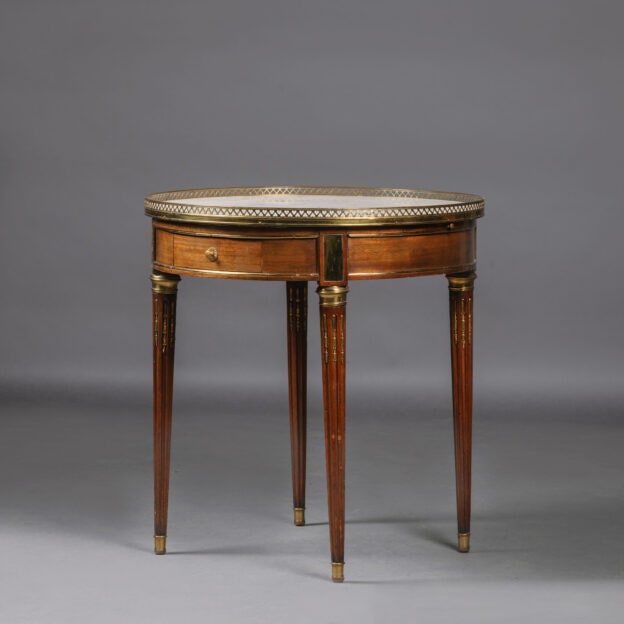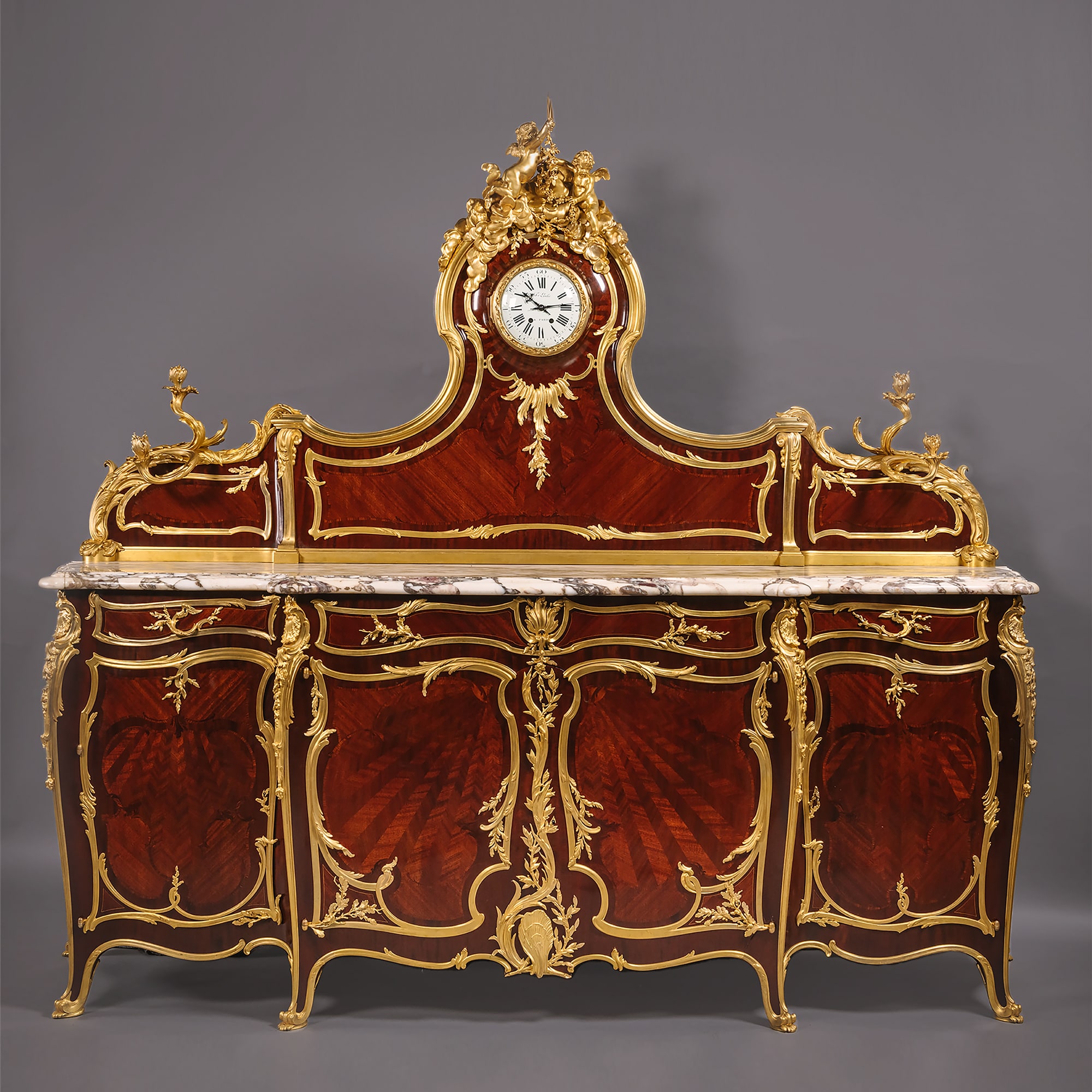弗朗索瓦-林克
罕见的Belle Epoque鎏金铜嵌花大自助餐
POA
A Rare Belle Epoque Gilt-Bronze Mounted Parquetry Inlaid Grand Buffet, By François Linke, The Mounts Designed by Léon Messagé. Signed to the right...
尺寸
Height: 226 cm (89 in)Width: 262 cm (104 in)
Depth: 79 cm (32 in)
Weight: 544 kg
描述
A Rare Belle Epoque Gilt-Bronze Mounted Parquetry Inlaid Grand Buffet, By François Linke, The Mounts Designed by Léon Messagé.
Signed to the right corner clasp ‘Linke’
The enamel clock dial with Roman numerals and Signed ‘F Linke A PARIS’.
The lockplate stamped ‘Ct Linke Serrurerie Paris’ and with the index number ‘2184’.
One of the rarest and most impressive of Linke’s creations this magnificent buffet cabinet is recorded as a pièce unique. Made to the exacting standards of François Linke’s production as the most prized ébéniste of the Belle Epoque, and dating to the height of his creative powers, this cabinet is a glorious flourishing of the Ebènisterie d’Art.
The ambition of the design, which is executed on grand proportions, the abundance of gilt-bronze sculptural mounts and radiating sunray Bois de Violette veneers, make it a definitive example from Linke’s great exhibition period when he was awarded a medaille d’or at the Paris Exposition Universelle in 1900.
The superstructure of the gallery has a sweeping serpentine shape terminating in scrolled rocaille twin-light candelabra. At the centre rises an integral clock case surmounted by cherubs holding floral garlands. The putti are floating on clouds above the clock face and their foliate trails symbolize the dawning of a new day. The top of the cabinet is a monumental slab of brèche violette marble with a moulded edge and shaped around the cabinet structure whereby the central drawer and cupboard doors protrude forward from the flanking cupboards. The doors are fronted with cuivre doré frames and the whole is replete with a wealth of rocaille ornament culminating in Linke’s idiosyncratic shell mount. The angles have large shell-shaped mounts, the right clasp is clearly signed ‘Linke’.
Christopher Payne illustrates the buffet in François Linke’s showrooms at 170 Faubourg Sainte Antoine. Payne records that it is a pièce unique made for Mme. Brodsky in 1911. The brèche violette marble top was repolished by Linke’s workshops in 1929.

François Linke’s showrooms at 170 Faubourg Saint Antoine showing the present buffet. Christopher Payne records that it is a pièce unique made for Mme. Brodsky in 1911. The brèche violette marble top was repolished by Linke’s workshops in 1929 (Courtesy Christopher Payne/Linke Archive).
Mme. Brodsky
The Linke archive records that this buffet was a pièce unique made for a Mme. Brodsky in 1911. It can be speculated this this refers to the wife or daughter of Lazar Brodsky who was a Russian Imperial businessman of Jewish origin. Known as the “Sugar King of Kiev” Lazar Brodsky was born in 1848 in Zlatopol, modern day Ukraine in the family of Jewish entrepreneur Israel Brodsky. Together with his brother, Lazar Brodsky inherited their father’s sugar production and as head of Alexandria Society of Sugar Mills controlled a quarter of the total sugar production in the Russian Empire. Brodsky went on to develop commercial interests including in the Kyiv water board, tramlines, flour mills and steamships and was as a member of the St. Petersburg International Commercial Bank. Brodsky was widely known as a philanthropist and used his wealth to finance schools, the Jewish hospital in Kyiv and the construction of the biggest synagogue in Kyiv, which was built on the family estate and later named after him. His business and charitable works were recognised by his being awarded the Order of St. Vladimir.
In 1900, at the Universal Exhibition in Paris, Brodsky received the French Legion of Honour for the high quality of the goods produced at his plants. It is possible that he visited Linke’s award winning stand at the 1900 Exhibition and ordered this buffet. Lazar Brodsky died somewhat unexpectedly in 1904, with four daughters but no sons. After his death, his brother Lev inherited the dynasty. Following the Russian revolution, Lev emigrated to Paris in 1918. Perhaps this buffet was never delivered or bought back – the Linke archives record that the the brèche violette marble top being repolished by Linke’s workshops in 1929.
France, Circa 1910.
Léon Messagé
Léon Messagé (1842-1901) had a brilliant, but short lived career. He is best known for his incredible sculptural collaboration with François Linke for the 1900 Paris Exposition Universelle. A gifted sculptor, Messagé was also responsible for much of the design and creative work for Roux et Brunet and Joseph-Emmanuel Zwiener.
Messagé enjoyed great success as a designer/sculptor before his collaboration with Linke. Indeed he was mentioned as a gold medal winner at the 1889 International Exhibition and was especially praised for his work on a cabinet by Zwiener. He came into contact with Linke in 1885 and it appears from then on Linke employed him on a regular basis.
Messagé was primarily influenced by rococo ornament but he strove to re-interpret it. He did not produce slavish copies, and his original approach can be appreciated in Linke’s celebrated Grande Bibliothèque and Grand Bureau exhibited at the 1900 Paris Exposition Universelle. A number of drawings by Messagé are recorded and after his success at the exhibition of 1889 he was encouraged to publish his designs.
‘Cahier de dessins & croquis, style Louis XV: bronzes, orfèvrerie, décoration, meubles’ was first published by the sculptor himself, from his Paris address of 40 rue Sedaine. There were five sections with an elaborate title page surmounted by the sculptor’s cipher or talisman of a wing, a pun on his own name as the messenger to the Gods, a motif he used many times on the handles of furniture designed for Linke.
As a sculptor Messagé was trained to produce a wax maquette or model prior to working on a piece. It is especially interesting that his maquettes were of the piece of furniture in its entirety, a rare and exacting task occasionally seen for eighteenth century French Royal commissions. For Messagé it was not just a matter of producing decorative mounts; the piece was conceived as sculpture, bronze, timber and marquetry as one.
日期
约1910年
原产地
法国
中型
Gilt-Bronze and Mahogany
签名
Signed Right Hand Corner Mount 'F Linke'. The Clock Dial Also Signed 'F Linke'. The lockplate Stamped 'Ct Linke Serrurerie Paris 2184'.
弗朗索瓦-林克(1855-1946)是十九世纪末和二十世纪初最重要的巴黎橱柜制造商,也可能是他那个时期最受欢迎的橱柜制造商。
他于1855年出生在现在的捷克共和国的潘克拉兹小村庄。记录显示,林克曾在橱柜制造大师诺伊曼那里当过学徒,然后在1875年20岁时来到巴黎,在那里一直生活到1946年去世。
据了解,早在1881年,新生的林克作坊就活跃在巴黎的圣安托万大街(Faubourg Saint Antoine),在此期间,他为其他更成熟的制造商如扬森和克里格提供家具。
林克的工艺质量是他同时代的任何一个人都无法超越的,他在1900年巴黎世界博览会上的壮观展台达到了顶峰,他的Grand Bureau获得了金奖。他在这个展台上赌上了自己的财富和声誉,展出了几件令人叹为观止的家具,并配有质量和比例都很出色的雕塑支架。他的赌博成功了,他的声誉也建立起来了,以至于林克一直是巴黎最杰出的家具公司,直到第二次世界大战。
正如《艺术杂志》在1900年对林克的展台所做的报道一样。
林克先生的作品......是一个例子,说明在路易十五和十六的经典作品中寻找灵感,而不是在很大程度上复制这些伟大的作品,是可以做到的。林克先生的作品是真正意义上的原创,因此,对于追求展览中真正的艺术作品的聪明人来说,他是值得称赞的。在制作所展示的宏伟的家具时,运用了神奇的天赋,....。
林克独特风格的形成得益于他与雕塑家Léon Messagé的合作。林克和梅萨盖一起为林克1900年的展台设计了家具,高浮雕的寓言式人物栩栩如生,体现了林克将木雕、青铜和镶嵌等不同媒介无缝融合为一个动态统一整体的能力。
今天,林克最出名的是他的作品质量特别高,以及他的个人主义和创造性。他的所有作品都有最精美、最豪华的装潢,经常应用于相对简单的胴体上。他的作品在技术上的辉煌和所代表的艺术变革是永远不会被重复的。
参考文献。
Payne, Christopher.弗朗索瓦-林克,(1855 - 1946),《法国家具的美好时代》,古董收藏家俱乐部,(英国Woodbridge),2003。
梅耶,乔纳森.伟大的展览 - 伦敦,纽约,巴黎,费城,1851-1900,古董收藏家俱乐部,(英国Woodbridge),2006;第298 - 300页。
Ledoux - Lebard, Denise.Les Ébénistes du XIXe siècle, Les Editions de l'Amateur, (Paris), 1984; pp.439-43。
Revue Artistique & Industrielle,(巴黎),1900年7-8月。
Coral Thomsen, D. (ed), The Paris Exhibition 1900, The Art Journal, 1901; p.341.
Pièce unique made for a Mme. Brodsky in 1911.
Collection of Mr. and Mrs. William Myron Keck of Owlwood Estate, Beverly Hills, CA.
Payne, Christopher. François Linke, (1855 – 1946), The Belle Époque of French Furniture, Antique Collectors’ Club, (Woodbridge, UK), 2003. pp. 71-95, 463 (pl. 552).
Payne, Christopher. François Linke, 1855 – 1946, The Belle Époque of French Furniture, Antique Collectors’ Club, (Woodbridge, UK), 2003; pp. 71-95.
Mestdagh, Camille & Lécoules, Pierre. L’Ameublement d’art français: 1850-1900, Les Editions de l’Amateur, (Paris), 2010; pp. 173-176.





























 印刷品
印刷品